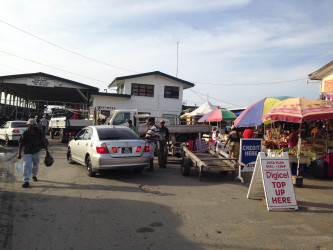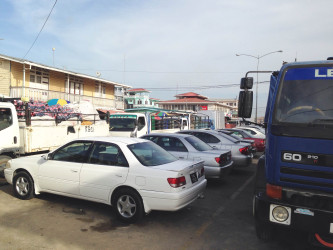By Shabna Rahman
Three years after the launch of the Chinese roll on/roll off ferries, commuters are satisfied that they arrive at their destinations much faster while others say better systems are needed for a smoother flow.

The MV Kanawan and MV Sabanto operate the Parika/Supenaam route in the Essequibo River simultaneously on a 5 am and 4 pm schedule.
Sometimes the boats are delayed for about half hour to facilitate late passengers or for maintenance purposes.
They take one and a half hours to reach their destinations and about another half hour to moor, depending on the tide.
Vehicle owners complained that the “ferry crossing is hard; we don’t get to cross sometimes because of too many vehicles.”
They told this newspaper too, that “they need to do another run, at least when there’s a lot of traffic.”
The cost to cross a small truck starts from $2,640 with an additional payment of $1,880 per tonne and for larger trucks, drivers pay $8,000 and with weight, it costs up to $20,000.
For cars and other small vehicles, the price start from $1,100 and for each passenger, the fare is $380.
The vessels, which boast a modern VIP lounge, have a seating capacity of 800 and can accommodate 20 trucks or 46 vehicles of all sizes.
Commuters are satisfied with the condition of the boats and are pleased that the workers make an effort to upkeep a high standard.

“I noticed that they are strict with sanitation. They have garbage bins placed all around the boat and they make checks to ensure that nobody litters,” according to a commuter.

“They clean up often and they ensure that nobody put their feet up on the seats. The washroom is not always clean but that is expected with the amount of people that travel.”
The commuters said that there is need for proper lighting at the stellings, especially in Essequibo, stressing that an elderly woman “fell one evening because she could not see where she was going.”
Vehicle owners noted that the “docking system” has been improved following the construction of the new wharf to accommodate the modern vessels.
They recalled that the new boats have taken away the stress they endured with the old ferry service.
“Sometimes we had to park up at the stelling for three or four days before we could get on the old boats,” they told this newspaper.
But even so, commuters had expected a much faster flow and less corruption.
Disappointment
Stabroek News spoke to some of the disgruntled truck owners as they waited to embark the ferry and they expressed disappointment at the way the boat is loaded at times.
They complained that they would “reach the stelling way ahead of time but yet we don’t get on sometimes and we would be stuck there for hours. When we get in front they tell you that you can’t make it on the boat; they put their own friends.”
The owners claimed that some vehicle owners buy their spaces on the boat, paying from $5,000 to $10,000.
They have seen it happening many times but even if they quarrel it does not make a difference because no one pays attention.
Most of the drivers have refused to pay and prefer to wait on the next boat. According to them, they barely make enough money from their businesses and cannot afford that additional expense.
Stabroek News was told that some drivers or businesspersons who carry perishables, like fish are allowed priority crossing, which they apply for ahead of time.
And while the other drivers do not have an objection to that, they claim that some people are abusing this privilege.
Some of the businesspersons who transport perishables said at times it is difficult for them to obtain a priority pass.
They would have to spend a long time at the stelling and sometimes “the ice would melt and the fish would spoil.”
Congestion
Meanwhile, drivers also complained about the congestion at the stelling that prevents the boats from loading freely.
They pointed out that the vendors are at one corner of the stelling and that the hire cars occupy a space just in front even though a no parking sign is painted on the road.
The boat vehicles have just a narrow section to pass, while other drivers have to use the same area to access the police station and other places. The drivers said this creates confusion and undue delay.
They also lamented that more hire cars encroach in the area where the trucks are lined up, resulting in them partially blocking the roadway.
According to the driver, this ugly situation can be avoided if the authorities take measures to implement the law and to provide adequate space for everyone to ply their trade.




